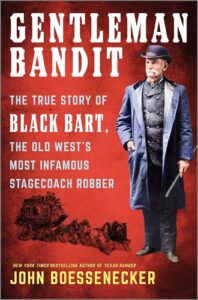“Please throw down the box.”
Stage driver John Shine nervously fingered the reins of his six-horse team as he stared down the yawning barrels of the highway robber’s shotgun. The bandit had suddenly appeared in front of Shine as he was urging his horses up the long, gradual slope of Funk Hill in the foothills of California’s Sierra Nevada Mountains. For a moment, Shine hesitated as he reached for the green Wells Fargo strongbox under his seat.
The bandit looked over his shoulder at the manzanita-choked hillside behind him and yelled, “If he dares to shoot, give him a solid volley, boys!”
Shine glanced up quickly and saw half a dozen rifle barrels protruding from the rocks and brush behind the bandit. They were aimed directly at his stage. The driver was certain that he was being held up by a large outlaw gang. He had no way of knowing that he was about to become the first victim of Black Bart, the Old West’s greatest stage robber.
Earlier on that fateful morning of July 26, 1875, Shine had stepped out of the stage depot in the gold town of Sonora and climbed onto the driver’s seat of his “mud wagon.” Fancy stagecoaches made by the Abbot-Downing Company of Concord, New Hampshire, had been used for two decades in the far west. But Concord coaches were expensive and hard to get. As a result, three-quarters of all stages on the frontier were inexpensive and uncomfortable mud wagons built by local wagon makers. Stagecoaches, including many mud wagons, could carry as many as ten passengers inside and another six on top. Valises and carpetbags were also carried on top, while trunks and large mailbags were placed in the rear boot, a platform with leather coverings at the back of the stage. As Shine hoisted the Wells Fargo & Company strongbox and the US mail pouch aboard, ten passengers crammed aboard his stage. Some took seats inside and others on top, directly behind the driver and also on the rear “dickey” seat.
Any coach that carried a strongbox filled with treasure would customarily be accompanied by a Wells Fargo shotgun messenger, or express guard. He rode on the front seat, known as the driver’s box or the front boot, and sat next to the reinsman. Shotgun messengers were hired for their courage, skill with firearms, and willingness to fight if attacked by bandits. And contrary to popular belief, shotgun messengers did not guard stagecoaches and their passengers. They guarded Wells Fargo’s express shipments. Shine’s coach carried two Wells Fargo strongboxes. One was the standard wood and iron-strapped chest placed underneath the driver’s seat. The other was a locked iron box, known as a “pony safe” because of its small size, bolted to the floor and concealed under the inside rear passenger seat. On this morning, the box under the driver’s seat held only $174 in bills, while $655 in gold coin was locked in the pony safe. For Wells Fargo, it was a minor shipment, and as a result, no shotgun messenger rode on the stage. Shine gave the guard’s usual seat to a woman passenger. That was considered the seat of honor.
A traveler on a Sierra Nevada stage once explained, “As every one knows, the most desirable of all places on a stagecoach is that known as the ‘box-seat.’ This is with the coachman; for, if he is intelligent, and in a good humor, he can tell you of all the sights by the way; with the personal history of nearly every man and woman you may meet; the qualities and ‘points’ of every horse upon the road; with all the adventures, jokes, and other good things he has seen and heard during his thousand and one trips, under all kinds of circumstances, and in all sorts of weather. In short, he is a living road-encyclopedia, to be read and studied at intervals, by the occupant of the ‘box-seat.’
John Shine, twenty-seven years old, was a very experienced driver. And he was no stranger to guns or to violence. In 1865, at just sixteen, he ran away from his father’s homestead in Wisconsin, lied about his age, and joined the Union Army in Chicago. He served during the final months of the Civil War, then returned to the family farm. Three years later, seeking adventure, he traveled by steamship to California and worked as a gold miner in the Sierra Nevada foothills of Amador County. In 1869 he became a stagecoach driver, variously known as a whip, a reinsman, or a jehu, the last nickname derived from the chariot-driving biblical king of Israel. Each of the driver’s reins, or ribbons, controlled one horse. The two animals at the front of the team were called the lead horses, or leaders; the pair closest to the driver were the wheel horses, or wheelers. A stagecoach driver also carried a whip, but he did not use it to flay the team. Instead, he would crack it above the animals’ heads to urge them forward. It took extraordinary skill for a reinsman to manage a four- or six-horse team on twisting mountain roads. Stage drivers were hugely popular on the frontier because they were a primary connection with the outside world, and so widely respected that they were called “knights of the whip.”
John Shine worked hard as a jehu, and in 1873 he managed to purchase a one-third interest in a large stage line headquartered in the prominent mining town of Sonora. Though he had become an owner, his principal job remained guiding coaches up and down the mountains between Sonora and the railhead in Milton. From Milton, a narrow-gauge railroad led thirty miles west to the city of Stockton, which in turn connected with the transcontinental railroad run by the Central Pacific. The stages on the Sonora-Milton route carried both passengers and gold from the mines in the Sierra Nevada foothills. Therefore, they were a favorite target of highway robbers.
Shine’s stage rolled out of Sonora, headed for Milton, forty miles west. Eight of the passengers were women and children. The only men aboard were John Olive, one of Shine’s partners in the stage line, and a young gold miner from Sonora who carried a holstered six-gun. The two men rode inside the stage, and no one else was armed. As Shine called to his horses and chatted with the passengers, he guided the coach down the stage road that skirted tall hills richly covered with manzanita and scrub oak. The route followed modern-day Highway 49—named after the major gold rush year—to the Reynolds Ferry crossing on the San Joaquin River. The road down into the river canyon was steep and winding until it reached the ferry. Today Reynolds Ferry is covered by the huge New Melones reservoir. But in that era, it featured a pontoon boat that was pulled across the stream by ropes and workhorses, guided by a long wire cable.
Shine, much to the delight of the children, skillfully brought the coach aboard the ferry, soothed his horses as they drifted across the powerful stream, then eased his stage off the ramp on the opposite shore. From there it was a tough haul out of the river canyon and up Funk Hill, which is more mountain than hill. The stage road made a gradual three-mile ascent in a long curve around the side of Funk Hill, with its summit just to the right of, and about two hundred feet above, the roadway. As Shine’s stage rounded the side of Funk Hill, moving at a crawl, a lone figure suddenly rushed from behind a boulder to his right. The man wore a long, white, soiled duster to conceal his clothes. A flour sack mask with eye holes covered his head. Shine noticed that the man’s boots were wrapped with cloth in order to hide his tracks, and he had a lever-action Henry rifle slung across his back. But mostly he noticed the yawning bore of the bandit’s double-barreled shotgun, and several rifle barrels aimed at him from the roadside brush.
Shine yanked the reins to calm his frightened team. Then he quickly complied with the bandit’s orders to throw down the Wells Fargo express box and the mailbag. Inside the coach, the young miner drew his six-shooter. John Olive seized his hand and shoved the revolver downward so the robber would not see it.
“Put that damned thing away,” Olive whispered hoarsely. “Do you want to get us all killed?”
The miner took his advice and holstered his pistol. Several of the women passengers gasped and shrieked in terror at the ghostly, shotgun-wielding apparition. One tossed her purse out the window. The highwayman picked it up and handed it back to her. Then he bowed deeply and spoke in a hollow, raspy voice.
“I don’t want your money. I only want boxes.”
The robber did not know that there was a Wells Fargo safe under the back seat. Thinking he had secured the entire express shipment, he called to Shine, “That will be about all, boys. Drive on.”
Shine cracked his whip, and his coach lurched forward. He glanced over his shoulder and saw the bandit hacking at the strongbox with a hatchet. The jehu continued up the grade and around a bend until he was well out of sight. Then he jumped down from the front boot and started back toward the holdup site. Meanwhile the bandit was still chopping at the Wells Fargo box when a second stagecoach hove into sight. Its driver, Donald McLean, was bringing several passengers from Sonora to the Milton railhead. He had left Sonora well after Shine. The highwayman covered McLean with his shotgun and again politely demanded, “Please throw down the box.”
“It is a private stage and carries no express box,” McLean told him. The robber, instead of searching the coach or robbing the passengers, simply waved him on. McLean urged his horses forward, and farther up the grade he encountered Shine. The two drivers, with several male passengers, cautiously walked back to the holdup site. By the time they got there, the robber had vanished. The shattered express box, now empty, lay near the roadway. Next to it was the mail sack, cut open with a slit in the shape of a T and also empty. Registered letters were a favorite target of bandits, for they often held paper money or gold dust. Shine looked across the road at the rocks and the mesquite where the rifle barrels were still aimed toward the road. He approached cautiously and was flabbergasted to find that the rifles were actually sticks, cleverly positioned by the bandit.
___________________________________
Excerpted from Gentleman Bandit: The True Story of Black Bart, the Old West’s Most Infamous Stagecoach Robber by John Boessenecker © 2023 by John Boessenecker, used with permission from Hanover Square Press.


















